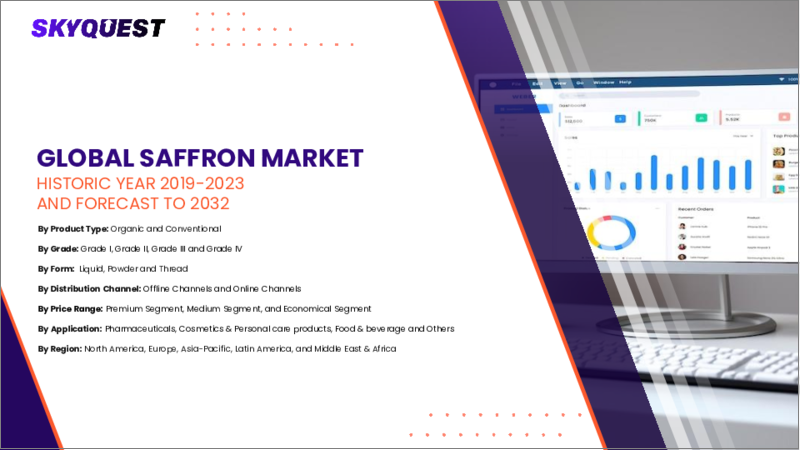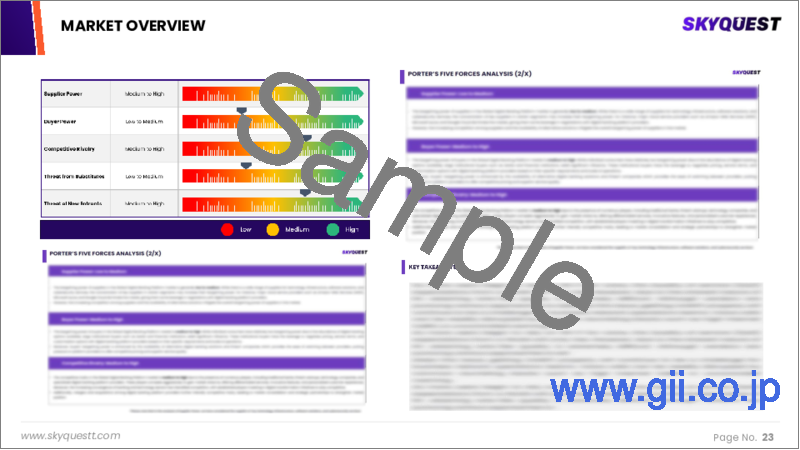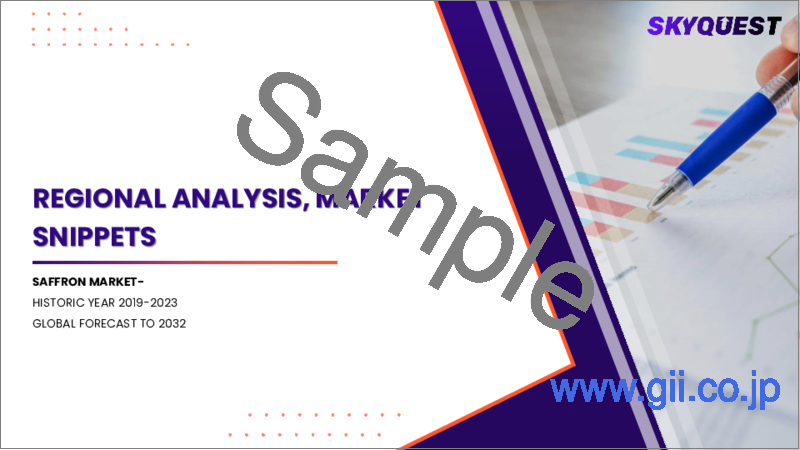|
|
市場調査レポート
商品コード
1673724
サフラン市場規模、シェア、成長分析、グレード別、製品タイプ別、形状別、流通チャネル別、用途別、地域別 - 産業予測、2025-2032年Saffron Market Size, Share, and Growth Analysis, By Grade (Grade I, Grade II), By Product Type (Organic, Traditional), By Form, By Distribution Channel, By Application, By Region - Industry Forecast 2025-2032 |
||||||
|
|||||||
| サフラン市場規模、シェア、成長分析、グレード別、製品タイプ別、形状別、流通チャネル別、用途別、地域別 - 産業予測、2025-2032年 |
|
出版日: 2025年03月01日
発行: SkyQuest
ページ情報: 英文 198 Pages
納期: 3~5営業日
|
全表示
- 概要
- 目次
サフラン市場規模は2023年に5億8,000万米ドルと評価され、予測期間(2025-2032年)のCAGRは3.6%で、2024年の6億88万米ドルから2032年には7億9,738万米ドルに成長すると予測されています。
サフランは化粧品と医薬品の両方の用途で需要が伸びており、今後数年間で大幅な市場成長が見込まれます。サフランはその健康効果で有名で、主にピクロクロシン、サフラニン、クロシンなどの活性化合物を特徴とする抗酸化物質が豊富に含まれており、脳の炎症や酸化ストレスを軽減することが知られています。これらの特性は、記憶力を高めるだけでなく、抗炎症効果ももたらし、市場拡大をさらに後押しします。化粧品では、サフランが天然の紫外線吸収剤として評価されています。人工電子鼻や画像処理技術などの技術の進歩により、サフランの処理効率が向上し、従来の方法よりも時間が短縮されています。しかし、世界の需要の高まりにより不純物が増加し、品質と価格に影響を与えています。サフランの健康効果に対する認識は、米国市場での需要を高め続けています。
目次
イントロダクション
- 調査の目的
- 調査範囲
- 定義
調査手法
- 情報調達
- 二次と一次データの方法
- 市場規模予測
- 市場の前提条件と制限
エグゼクティブサマリー
- 世界市場の見通し
- 供給と需要の動向分析
- セグメント別機会分析
市場力学と見通し
- 市場概要
- 市場規模
- 市場力学
- 促進要因と機会
- 抑制要因と課題
- ポーターの分析
主な市場の考察
- 重要成功要因
- 競合の程度
- 主な投資機会
- 市場エコシステム
- 市場の魅力指数(2024年)
- PESTEL分析
- マクロ経済指標
- バリューチェーン分析
- 価格分析
- 規制情勢
- ケーススタディ
- 貿易分析
- 顧客と購買基準の分析
サフラン市場規模:グレード別
- 市場概要
- グレードI
- グレード II
- グレードIII
- グレードIV
サフラン市場規模:製品タイプ別
- 市場概要
- オーガニック
- 伝統的
サフラン市場規模:形状別
- 市場概要
- 液体
- 粉末
- 柱頭
- 花弁
- 雄しべ
サフラン市場規模:流通チャネル別
- 市場概要
- 企業向け
- 消費者向け
サフラン市場規模:用途別
- 市場概要
- 栄養補助食品
- 化粧品
- パーソナルケア製品
- 食料・飲料
- その他
サフラン市場規模
- 北米
- 米国
- カナダ
- 欧州
- ドイツ
- スペイン
- フランス
- 英国
- イタリア
- その他欧州地域
- アジア太平洋地域
- 中国
- インド
- 日本
- 韓国
- その他アジア太平洋地域
- ラテンアメリカ
- ブラジル
- その他ラテンアメリカ地域
- 中東・アフリカ
- GCC諸国
- 南アフリカ
- その他中東・アフリカ
競合情報
- 上位5社の比較
- 主要企業の市場ポジショニング(2024年)
- 主な市場企業が採用した戦略
- 最近の市場動向
- 企業の市場シェア分析(2024年)
- 主要企業の企業プロファイル
- 企業の詳細
- 製品ポートフォリオ分析
- 企業のセグメント別シェア分析
- 収益の前年比比較(2022-2024)
主要企業プロファイル
- Esfedan Saffron Co.(Iran)
- Safran Global Company S.L.U.(Spain)
- Tarvand Saffron Co.(Iran)
- Saffron Business Company(Iran)
- Gohar Saffron(Iran)
- Rowhani Saffron Co.(Iran)
- Mehr Saffron(Iran)
- Flora Saffron(Iran)
- Royal Saffron Company(Iran)
- Iran Saffron Company(Iran)
- Givaudan(Switzerland)
- Lesaffre(France)
- Synthite Industries(India)
- International Flavors & Fragrances(USA)
- USMS Saffron Co.(India)
- Natac(Spain)
- SoulTree(India)
- Veggitech(UAE)
- Novin Saffron(Iran)
- Shahri Saffron(Iran)
結論と提言
Saffron Market size was valued at USD 580.0 million in 2023 and is poised to grow from USD 600.88 million in 2024 to USD 797.38 million by 2032, growing at a CAGR of 3.6% during the forecast period (2025-2032).
The growing demand for saffron in both cosmetic and medicinal applications is poised to drive significant market growth in the coming years. Renowned for its health benefits, saffron is rich in antioxidants, primarily featuring active compounds like picrocrocin, safranin, and crocin, which are known to reduce inflammation and oxidative stress in the brain. These properties not only enhance memory but also offer anti-inflammatory benefits, further fueling market expansion. In cosmetics, saffron is valued for its natural UV-absorbing qualities. Technological advancements, such as electric nose and image processing techniques, are improving the efficiency of saffron processing, reducing time compared to traditional methods. However, rising global demand has led to increased adulteration, impacting quality and pricing. Awareness of saffron's health benefits continues to elevate its demand in the U.S. market.
Top-down and bottom-up approaches were used to estimate and validate the size of the Saffron market and to estimate the size of various other dependent submarkets. The research methodology used to estimate the market size includes the following details: The key players in the market were identified through secondary research, and their market shares in the respective regions were determined through primary and secondary research. This entire procedure includes the study of the annual and financial reports of the top market players and extensive interviews for key insights from industry leaders such as CEOs, VPs, directors, and marketing executives. All percentage shares split, and breakdowns were determined using secondary sources and verified through Primary sources. All possible parameters that affect the markets covered in this research study have been accounted for, viewed in extensive detail, verified through primary research, and analyzed to get the final quantitative and qualitative data.
Saffron Market Segments Analysis
Global Saffron Market is segmented by Grade, Product Type, Form, Distribution Channel, Application and region. Based on Grade, the market is segmented into Grade I, Grade II, Grade III and Grade IV. Based on Product Type, the market is segmented into Organic and Traditional. Based on Form, the market is segmented into Liquid, Powder, Stigma, Petals and Stamen. Based on Distribution Channel, the market is segmented into B2B and B2C. Based on Application, the market is segmented into Food supplements,Cosmetics, Personal care products, Food & beverage and Others. Based on region, the market is segmented into North America, Europe, Asia Pacific, Latin America and Middle East & Africa.
Driver of the Saffron Market
The saffron market is significantly driven by its long-standing use in traditional medicine, attributed to its potential health benefits. Rich in bioactive compounds such as crocin, safranin, and picrocrocin, saffron is renowned for its antioxidant, anti-inflammatory, and antidepressant qualities. As more individuals become aware of these therapeutic advantages, there has been a notable surge in the demand for saffron-infused dietary supplements and herbal treatments. This growing interest in natural health solutions continues to propel the saffron market forward, as consumers increasingly seek products that contribute to their overall well-being and enhance their quality of life.
Restraints in the Saffron Market
The saffron market faces significant constraints due to the cultivation of this spice being confined to a limited number of regions, primarily Iran, Spain, India, and Afghanistan. These areas possess unique climatic and soil conditions that are essential for the successful growth of saffron. As a result, the restricted geographical distribution of saffron significantly impacts its overall availability, leading to potential supply shortages. This limited supply can contribute to price volatility and fluctuations in the saffron market, making it challenging for producers and consumers alike to predict market trends and stabilize prices over time.
Market Trends of the Saffron Market
The saffron market is witnessing a notable trend towards the incorporation of saffron into functional foods and beverages, as consumers increasingly seek products that offer enhanced health benefits alongside basic nutrition. Innovative manufacturers are exploring saffron-infused items, such as teas, energy bars, health supplements, and fortified beverages, catering to the growing demographic of health-conscious individuals. This shift is underpinned by a rising preference for natural and plant-based ingredients, reflecting broader consumer demands for quality, wellness-oriented products. As a result, the saffron market is poised for expansion, driven by its unique flavor, aroma, and myriad health-promoting properties.
Table of Contents
Introduction
- Objectives of the Study
- Scope of the Report
- Definitions
Research Methodology
- Information Procurement
- Secondary & Primary Data Methods
- Market Size Estimation
- Market Assumptions & Limitations
Executive Summary
- Global Market Outlook
- Supply & Demand Trend Analysis
- Segmental Opportunity Analysis
Market Dynamics & Outlook
- Market Overview
- Market Size
- Market Dynamics
- Drivers & Opportunities
- Restraints & Challenges
- Porters Analysis
- Competitive rivalry
- Threat of substitute
- Bargaining power of buyers
- Threat of new entrants
- Bargaining power of suppliers
Key Market Insights
- Key Success Factors
- Degree of Competition
- Top Investment Pockets
- Market Ecosystem
- Market Attractiveness Index, 2024
- PESTEL Analysis
- Macro-Economic Indicators
- Value Chain Analysis
- Pricing Analysis
- Regulatory Landscape
- Case Studies
- Trade Analysis
- Customer & Buying Criteria Analysis
Global Saffron Market Size by Grade & CAGR (2025-2032)
- Market Overview
- Grade I
- Grade II
- Grade III
- Grade IV
Global Saffron Market Size by Product Type & CAGR (2025-2032)
- Market Overview
- Organic
- Traditional
Global Saffron Market Size by Form & CAGR (2025-2032)
- Market Overview
- Liquid
- Powder
- Stigma
- Petals
- Stamen
Global Saffron Market Size by Distribution Channel & CAGR (2025-2032)
- Market Overview
- B2B
- B2C
Global Saffron Market Size by Application & CAGR (2025-2032)
- Market Overview
- Food supplements
- Cosmetics
- Personal care products
- Food & beverage
- Others
Global Saffron Market Size & CAGR (2025-2032)
- North America (Grade, Product Type, Form, Distribution Channel, Application)
- US
- Canada
- Europe (Grade, Product Type, Form, Distribution Channel, Application)
- Germany
- Spain
- France
- UK
- Italy
- Rest of Europe
- Asia Pacific (Grade, Product Type, Form, Distribution Channel, Application)
- China
- India
- Japan
- South Korea
- Rest of Asia-Pacific
- Latin America (Grade, Product Type, Form, Distribution Channel, Application)
- Brazil
- Rest of Latin America
- Middle East & Africa (Grade, Product Type, Form, Distribution Channel, Application)
- GCC Countries
- South Africa
- Rest of Middle East & Africa
Competitive Intelligence
- Top 5 Player Comparison
- Market Positioning of Key Players, 2024
- Strategies Adopted by Key Market Players
- Recent Developments in the Market
- Company Market Share Analysis, 2024
- Company Profiles of All Key Players
- Company Details
- Product Portfolio Analysis
- Company's Segmental Share Analysis
- Revenue Y-O-Y Comparison (2022-2024)
Key Company Profiles
- Esfedan Saffron Co. (Iran)
- Company Overview
- Business Segment Overview
- Financial Updates
- Key Developments
- Safran Global Company S.L.U. (Spain)
- Company Overview
- Business Segment Overview
- Financial Updates
- Key Developments
- Tarvand Saffron Co. (Iran)
- Company Overview
- Business Segment Overview
- Financial Updates
- Key Developments
- Saffron Business Company (Iran)
- Company Overview
- Business Segment Overview
- Financial Updates
- Key Developments
- Gohar Saffron (Iran)
- Company Overview
- Business Segment Overview
- Financial Updates
- Key Developments
- Rowhani Saffron Co. (Iran)
- Company Overview
- Business Segment Overview
- Financial Updates
- Key Developments
- Mehr Saffron (Iran)
- Company Overview
- Business Segment Overview
- Financial Updates
- Key Developments
- Flora Saffron (Iran)
- Company Overview
- Business Segment Overview
- Financial Updates
- Key Developments
- Royal Saffron Company (Iran)
- Company Overview
- Business Segment Overview
- Financial Updates
- Key Developments
- Iran Saffron Company (Iran)
- Company Overview
- Business Segment Overview
- Financial Updates
- Key Developments
- Givaudan (Switzerland)
- Company Overview
- Business Segment Overview
- Financial Updates
- Key Developments
- Lesaffre (France)
- Company Overview
- Business Segment Overview
- Financial Updates
- Key Developments
- Synthite Industries (India)
- Company Overview
- Business Segment Overview
- Financial Updates
- Key Developments
- International Flavors & Fragrances (USA)
- Company Overview
- Business Segment Overview
- Financial Updates
- Key Developments
- USMS Saffron Co. (India)
- Company Overview
- Business Segment Overview
- Financial Updates
- Key Developments
- Natac (Spain)
- Company Overview
- Business Segment Overview
- Financial Updates
- Key Developments
- SoulTree (India)
- Company Overview
- Business Segment Overview
- Financial Updates
- Key Developments
- Veggitech (UAE)
- Company Overview
- Business Segment Overview
- Financial Updates
- Key Developments
- Novin Saffron (Iran)
- Company Overview
- Business Segment Overview
- Financial Updates
- Key Developments
- Shahri Saffron (Iran)
- Company Overview
- Business Segment Overview
- Financial Updates
- Key Developments





